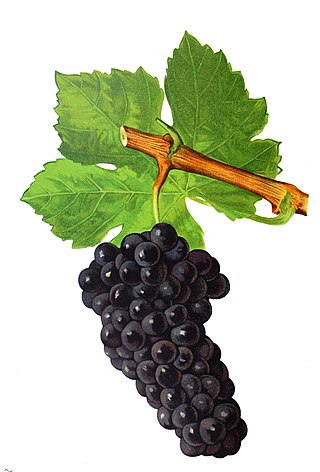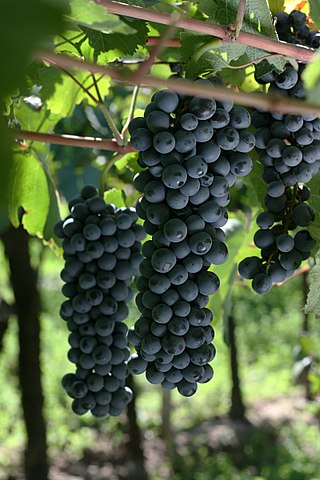Related Research Articles

Syrah, also known as Shiraz, is a dark-skinned grape variety grown throughout the world and used primarily to produce red wine. In 1999, Syrah was found to be the offspring of two obscure grapes from southeastern France, Dureza and Mondeuse Blanche. Syrah should not be confused with Petite Sirah, a cross of Syrah with Peloursin dating from 1880.

Pinot noir is a red-wine grape variety of the species Vitis vinifera. The name may also refer to wines created predominantly from pinot noir grapes. The name is derived from the French words for pine and black. The word pine alludes to the grape variety having tightly clustered, pinecone–shaped bunches of fruit.

Zinfandel is a variety of black-skinned wine grape. The variety is grown in over 10 percent of California vineyards. DNA analysis has revealed that it is genetically equivalent to the Croatian grapes Crljenak Kaštelanski and Tribidrag, as well as to the Primitivo variety traditionally grown in Apulia, where it was introduced in the 18th century, and Kratošija in Montenegro. The grape found its way to the United States in the mid-19th century, where it became known by variations of a name applied to a different grape, likely "Zierfandler" from Austria.

Durif is a variety of red wine grape primarily grown in Australia, California, France, and Israel. Since the end of the 20th century, wineries located in Washington's Yakima River Valley, Maryland, Arizona, Texas, West Virginia, Chile, Mexico's Baja California Peninsula, and Ontario's Niagara Peninsula have also produced wines from Durif grapes. It is the main grape known in the U.S. and Israel as Petite Sirah, with over 90% of the California plantings labeled "Petite Sirah" being Durif grapes; the U.S. Bureau of Alcohol, Tobacco, Firearms and Explosives (ATF) recognizes "Durif" and "Petite Sirah" as synonyms for the same grape. It produces tannic wines with a spicy, plummy flavour. The grape originated as a cross of Syrah pollen germinating a Peloursin plant. On some occasions, Peloursin and Syrah vines may be called Petite Sirah, usually because the varieties are extremely difficult to distinguish in old age.

Torrontés is a white grape variety, mostly produced and known in Argentine wine, producing fresh, aromatic wines with moderate acidity, smooth texture and mouthfeel as well as distinctive peach and apricot aromas on the nose. Three Torrontés varieties exist in Argentina: Torrontés Riojano, the most common, Torrontés Sanjuanino, and Torrontés Mendocino. It is primarily Torrontés Riojano that has received attention for the quality of its wines, and is the variety used for most Argentine wines simply labeled Torrontés.

Plavac Mali, a cross between Crljenak Kaštelanski and Dobričić grapes, is the primary red wine grape grown along the Dalmatian coast of Croatia. The name refers to the small blue grapes that the vines produce: in Croatian plavo means blue; mali means small.

Mondeuse noire is a red French wine grape variety that is grown primarily in the Savoy region of eastern France. The grape can also be found in Argentina, Australia, California, Switzerland and Sicily. Plantings of Mondeuse noire was hit hard during the phylloxera epidemic of the mid to late 19th century which nearly wiped out the vine from eastern France. While the grape recovered slightly in the 20th century, French plantations of Mondeuse noire fell sharply in the 1970s, with just over 200 hectares left in France in 2000. In the early 21st century, it seems the variety has increased somewhat in popularity, as it can give good wines if the planting site is chosen carefully.
Peloursin is red French wine grape variety best known for crossing with Syrah to make the red wine grape Durif. The variety is believed to have originated in Isère from the northern Rhône-Alpes region. Today Peloursin can be found in some quantities in California and in the Australia wine region of Victoria.

The Mendocino County wine is an appellation that designates wine made from grapes grown mostly in Mendocino County, California. The region is part of the larger North Coast AVA and one of California's largest and most climatically diverse wine growing regions. Mendocino County is one of the northernmost commercial wine grape regions in the state with two distinct climate zones separated by the Mendocino Range. Ten American Viticultural Areas have been designated within Mendocino County. Mendocino is one of the leading wine growing regions for organically produced wine grapes. Nearly 25% of the acreage in Mendocino County is grown organically. In 2004, the residents of the county voted to become the first GMO-free county in the United States in an initiative that was supported by many of the county's largest wineries. The county's widespread focus on organic viticulture has inspired journalists to describe it as "California's organic wine Mecca".

California wine production has a rich viticulture history since 1680 when Spanish Jesuit missionaries planted Vitis vinifera vines native to the Mediterranean region in their established missions to produce wine for religious services. In the 1770s, Spanish missionaries continued the practice under the direction of the Father Junípero Serra who planted California's first vineyard at Mission San Juan Capistrano.

Dureza is a dark-skinned French wine grape variety from the Ardèche department of south central France in the Rhône-Alpes region. The grape is most widely known for being the father vine of Syrah—a discovery that confirmed that the Syrah vine was native to France and not introduced to the country from Persia, Sicily, Egypt or elsewhere, as had been speculated.
Sean Haley Thackrey was an American winemaker based in the town of Bolinas in Marin County, California. Prior to winemaking, he was a director of an art gallery. Thackrey has been described as having been an unconventional winemaker who did pioneering work in promoting California Syrah.

Hagafen Cellars is a winery located in the Napa Valley. Founded in 1979, it was the first kosher winery in California, and is "the first of the upscale kosher brands." The winery is owned and operated by winemaker Ernie Weir and his wife, Irit Weir.

Wine Grapes - A complete guide to 1,368 vine varieties, including their origins and flavours is a reference book about varieties of wine grapes. The book covers all grape varieties that were known to produce commercial quantities of wine at the time of writing, which meant 1,368 of the known 10,000 varieties. It is written by British Masters of Wine Jancis Robinson and Julia Harding in collaboration with Swiss grape geneticist Dr. José Vouillamoz.

Henry Walker Crabb, also known as H. W. Crabb, Hiram Walker Crabb or Hamilton Walker Crabb, was an American wine cultivator, considered one of the pioneers of the development of the Napa Valley as a wine region. In the 1880s, his vine collection was one of the largest in the world.
Merlot blanc is a white French wine grape variety that came from a natural crossing of the Bordeaux wine grape Merlot and the Cognac grape Folle blanche. The grape is distinct from Merlot gris which is a pink-skinned color mutation of the red wine grape Merlot and is sometimes used in vin gris and rosé wines. Plantings of Merlot blanc were first discovered in 1891 but cuttings of the vine have not been widely propagated and the variety is very rare. It is not used to make the sweet White Zinfandel-style wine White Merlot that is made by some California wine producers. Those wines are made from a saignee of red Merlot wine.

Douce noir is a red Savoyard wine grape variety that has historically been grown in the Savoy region, but today is more widely planted in Argentina.
The Zinfandel Advocates and Producers(ZAP) is a consortium of over 200 winemakers and grape growers, as well as thousands of consumers, with the purpose of advocating, preserving, and educating about the Zinfandel grape. Started in 1991, the organizational structure of combining wine enthusiasts with wine producers served as a successful template for other wine-related organizations, such as the Rhone Rangers. ZAP is reported to be one of the largest consumer-based wine advocacy groups in the world.
Grapevine red blotch disease (GRBD), also known simply as red blotch, is a viral disease of grapevine. The disease is caused by a single-stranded circular DNA virus, the species grapevine red blotch virus, also known as grapevine red blotch-associated virus, GRBaV. First identified in California, the disease affects grapevines of all varieties and is internationally present. Symptoms typically include red blotches on the leaves of red varieties and in pale green or pale yellow blotches on white varieties. It significantly reduces the value of juice collected from the berries of affected vines, costing vineyard owners as much as $65,000 per acre.
References
- 1 2 Lagier-Meredith: Who we are Archived August 21, 2008, at the Wayback Machine
- ↑ "Researchers Discover Zinfandel's Hidden Roots". UC Davis. 2002-09-03.
- ↑ USA, Slow Food. "Ark of Taste". Slowfood USA. Archived from the original on 2008-07-06. Retrieved 2006-07-30.
- 1 2 "Grape Geneticist Dr. Carole Meredith On Her Life Among the Vines - Grapecollective.com". grapecollective.com. Retrieved 2015-12-15.
- ↑ vinagency.com, Vin. "Lagier Meredith - A Small Mountain Vineyard". lagiermeredith.com.